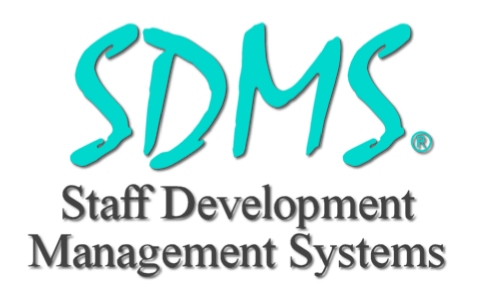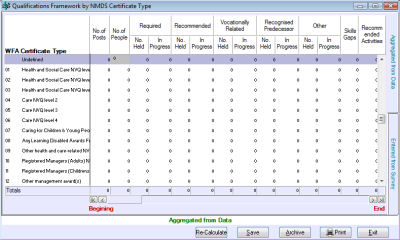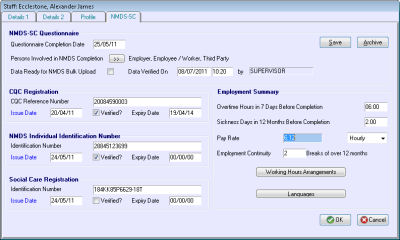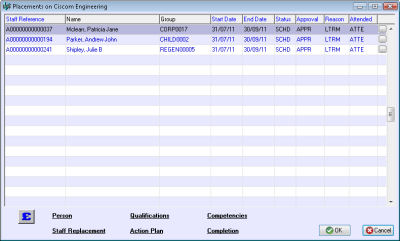This version of SDMS V Staff Development for English Social Services has been developed with several of the Country’s most innovative Departments and reflects the growing synergies between Workforce Management and Training Administration. It provides the definitive System for Management of Employee Training combined with Workforce Planning in English Social Services Departments. Given the increasing demand for Social Care amongst all age groups in the population to Employee Training is increasingly geared to reducing service deficits by addressing the long standing skills shortage in Social Care. This version allows training provided to be based on known information about the Workforce and enhances Training Administration, by being integrated with the Management of the NMDS-SC and Work Force Data.
Workforce Analysis Data
The special Work Force Planning Modules extend SDMS V Staff Development for Social Services into a tool for Workforce Analysis and Planning. Using the guidelines recommended by the Skills for Care, SDMS V Staff Development for Social Services allows the entry of Staff, Post and Post Assignment Data for Job Roles for all Staff, with Contract Types, Employment Status, and Working Hour’s arrangements. Additionally data on Recruitment Methods and Origins, Destinations and Reasons for Leaving can be held. Group (organisational), with Client Types and Client Areas are held together with both Skills and Qualifications Achievement and Skills and Qualifications Requirement Profile. Of course full and detailed Training Histories are maintained. Translations are provided to allow the Nationally Recommended Codes to be used without compromising the special local requirements of Social Services Departments or the requirements of the Professional Management and Planning of Training.
Workforce and Staff Analysis Tools
Work Force Analysis Tools are offered in powerful matrix-style format screens and spreadsheets outputs. Each is definable with Primary and Secondary Breakdowns, including all Equal Opportunity Indicators or any of the WFA Data Fields. An option is provided to enter the Aggregate Data from Surveys or accumulate from System Data – e.g. Records of Individual Employees. These include: Staffing levels and Staff Turnover, Volume of Training Analysis, Staff Retirement Forecasts for Succession Planning, Qualification Framework Analysis for Required, Recommended, Vocationally Related or Predecessor Qualifications, Qualification Achievement Analysis for Achieved, In Progress or To Be Achieved Qualifications. Once run, the completed matrix can be saved to spreadsheet and archived for future reference. Favourite Breakdowns can be saved for Repeat Runs. Data can be analysed for Groups Individually or for a Cluster of Groups or for Organisations as a whole or Partner Organisations.
Working with Partner Organisations and NMDS-SC for Individuals and Groups
Workforce Data can be recorded across the whole range of data required by the NMDS-SC for individual Staff whether Employees of the Local Authority, NHS or Voluntary or Partner Organisations. Such Data can be Exported to Spreadsheet for production of the NMDS Questionnaire or archived for reference. Data for internal Local Authority Organisation Units, Teams or Groups can be collected as well as similarly Data for External Partner Organisations with additional screens provided for recording NMDS-SC Data, including Sector, Service Areas and Client Type provision. Archive and Export to Spreadsheet of data required for the NMDS-SC Questionnaire at the Group Level are supported. WFA and Staffing Analysis Tools can be run for specific Group or across Group Types.
Qualifications and Skills Framework
The New Qualifications and Skills Framework Module allows the User to define Types of Certificates that Employees in each Post Type/Post needs to hold, with differentiation between Required, Recommended, Vocationally Related or recognised Predecessor Qualifications. Qualifications can be analysed by Certificate Types already held in the System, or translated into the NMDS-SC Codes and Grouped into Management, Professional and Social Care Qualifications. The Staff Qualification Profile includes Achievement Status, which links to the Qualifications and Skills Framework to Identify and Report on the Qualifications Already Held (from Previous Training or gained elsewhere), To be Achieved (from Post Requirements) or In Progress (if enrolled on a Training Course or QCF that leads towards it). Skill Gaps and Recommended Training Courses can be identified. Qualifications can be identified with Equivalent Blocks for Cross Referenced Analysis.
Practice Placements, Employee Training History, Security Checks and PINs
Individual Training History encompasses Internally Provided Training as well as Self Study, External Training and Training Received Before Joining the Organisation, giving a complete picture of all training received by an individual. Practice Placements can be managed, including the Tracking of Providers, Competencies to be Gained, and Qualifications and Costing. All Competencies and Qualifications can be related to QCF Qualifications and Units. Monitoring Security Checks from Initiation to Completion and Expiry with User Defined Triggers and Warnings is included. These can vary from CRB Checks to Registrations with Professional Bodies. Registrations of Social Care Workers and the PIN Numbers can be Recorded with Reminders when they are Due to Expire.












